Landing Zones 1 and 2
 The first-stage booster core B1019 of Falcon 9 flight 20 approaching Landing Zone 1 in December 2015 | |||||||||||||||||||||||||
 | |||||||||||||||||||||||||
| Launch site | Cape Canaveral Space Force Station | ||||||||||||||||||||||||
|---|---|---|---|---|---|---|---|---|---|---|---|---|---|---|---|---|---|---|---|---|---|---|---|---|---|
| Coordinates | 28°29′09″N 80°32′40″W / 28.48583°N 80.54444°W | ||||||||||||||||||||||||
| Short name | LZ-1, LZ-2 | ||||||||||||||||||||||||
| Operator | SpaceX | ||||||||||||||||||||||||
| |||||||||||||||||||||||||
Landing Zone 1 and Landing Zone 2, also known as LZ-1 and LZ-2 respectively, are landing facilities at Cape Canaveral Space Force Station used by SpaceX. They allow the company to land the first stage of its Falcon 9 rocket or the two side boosters of its Falcon Heavy rocket.
The facilities were built on land leased in February 2015 on the site of the former Launch Complex 13.[1][2] Landing Zone 1 saw its first use on 21 December 2015 when B1019 touched down during Falcon 9 flight 20. Landing Zone 2 was added ahead of the first Falcon Heavy test flight on 6 February 2018. During a Falcon Heavy launch, both LZ’s are used allowing the two side boosters to land simultaneously.
Site
[edit]Landing Zones 1 and 2 are located at the former location of Launch Complex 13, which has been demolished and replaced by two circular landing pads 282 feet (86 m) in diameter and marked with a stylized X from the SpaceX company logo.[3][4] Four more 150 feet (46 m) diameter pads were initially planned to be built to support the simultaneous recovery of additional boosters used by the Falcon Heavy, although only one extra pad has been built. Planned infrastructure additions to support operations includes improved roadways for crane movement, a rocket pedestal area, remote-controlled fire suppression systems in case of a landing failure, and a large concrete foundation, away from the future three landing pads, for attaching the booster stage when taking the rocket from vertical to horizontal orientation.[4]
Operations at the facility began after seven earlier landing tests by SpaceX, five of which involved intentional descents into the open ocean, followed by two failed landing tests on an ocean-going platform.[5][6] As of March 2, 2015, the Air Force's sign for LC-13 was briefly replaced with a sign identifying it as Landing Complex.[7] The site was renamed Landing Zone prior to its first use as a landing site.[8][9] Elon Musk indicated in January 2016 that he thought the likelihood of successful landings for all of the attempted landings in 2016 would be approximately 70 percent, hopefully rising to 90 percent in 2017, and cautioned that the company expects a few more failures.[10]
In July 2016, SpaceX applied for permission to build two additional landing pads at Landing Zone 1 for landing the boosters from Falcon Heavy flights.[11]
In May 2017, construction on a second, smaller pad began, called Landing Zone 2. This pad is located about 1,017 feet (310 m) to the northwest of the first pad and is used for landing Falcon Heavy side boosters.[12] By June 2017, the landing pad was modified with a radar reflective paint, to aid with landing precision.[13]
Falcon 9 boosters mostly land on LZ-1 pad and rarely land on LZ-2, except in cases when a Cape Canaveral launched booster cannot land on LZ-1, as a previous booster is still sitting on that pad, as in case of Hakuto-R Mission 1's booster B1073.5 on 11 December 2022. The LZ-1 was already occupied by Oneweb Flight#15's booster B1069.4 launched on 8 December 2022, so LZ-2 was used by a Falcon 9 for the first time.
Landing history
[edit]LZ-1
[edit]- Falcon 9 Success
- Falcon Heavy Success
- Falcon 9 Failure
- Falcon Heavy Failure
LZ-2
[edit]- Falcon 9 Success
- Falcon Heavy Success
- Falcon 9 Failure
- Falcon Heavy Failure
Booster landings
[edit]
Detailed history
[edit]For landings at sea, see Autonomous spaceport drone ship
After approval from the FAA, SpaceX accomplished its first successful landing at the complex with Falcon 9 flight 20 on December 22, 2015 UTC;[14] this was the 8th controlled-descent test of a Falcon 9 first stage.[9][15] A second successful landing at LZ-1 took place shortly after midnight, local time (EDT) on July 18, 2016, as part of the CRS-9 mission, which was the Falcon 9's 27th flight.[16] The third successful landing was by the CRS-10 mission's first stage on February 19, 2017, which was the Falcon 9's 30th flight.[17] Landing Zone 2 was first used by the maiden launch of Falcon Heavy on February 6, 2018, when the rocket's two side boosters touched down on LZ-1 and LZ-2.[18]
-
A person standing in the middle of the main landing pad demonstrates its size
-
Sign at entrance to Landing Zone 1 site
-
Launch and landing traces of Falcon 9 Flight 20, from launch pad SLC-40 to landing pad LZ-1
-
First stage of Falcon 9 Flight 20 on the pad shortly after landing
-
Recovery operations after Falcon 9 Flight 20 landing
-
Double return of Falcon Heavy test flight boosters
| Date (UTC) | Mission | Launch vehicle Booster ID |
Flight № | Landing Zone | Landing | Result | ||
|---|---|---|---|---|---|---|---|---|
| December 22, 2015 01:39 | OG2-F2 | Falcon 9 Full Thrust B1019.1 |
20 | LZ-1 | 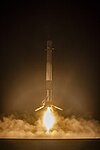 |
Success | ||
| July 18, 2016 04:53 | SpaceX CRS-9 | Falcon 9 Full Thrust B1025.1 |
27 | LZ-1 | 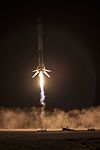 |
Success | ||
| February 19, 2017 14:47 | SpaceX CRS-10 | Falcon 9 Full Thrust B1031.1 |
30 | LZ-1 | 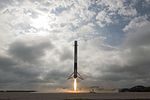
|
Success | ||
| May 1, 2017 11:24 | NROL-76 | Falcon 9 Full Thrust B1032.1 |
33 | LZ-1 | 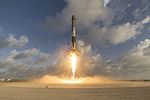
|
Success | ||
| June 3, 2017 21:15 | SpaceX CRS-11 | Falcon 9 Full Thrust B1035.1 |
35 | LZ-1 | 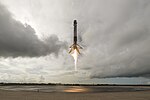
|
Success | ||
| August 14, 2017 16:39 | SpaceX CRS-12 | Falcon 9 Full Thrust B1039.1 (Block 4) |
39 | LZ-1 | 
|
Success | ||
| September 7, 2017 | OTV-5 (X-37B) | Falcon 9 Full Thrust B1040.1 (Block 4) |
41 | LZ-1 | 
|
Success | ||
| December 15, 2017 | SpaceX CRS-13 | Falcon 9 Full Thrust B1035.2 |
45 | LZ-1 | 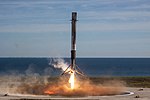
|
Success | ||
| January 8, 2018 | Zuma | Falcon 9 Full Thrust B1043.1 (Block 4) |
47 | LZ-1 | 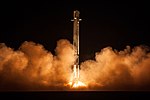
|
Success | ||
| February 6, 2018 | Elon Musk's Tesla Roadster | Falcon Heavy B1023.2, B1025.2 |
FH #1 | LZ-1 B1023.2 |
LZ-2 B1025.2 |

|
Success B1023.2 |
Success B1025.2 |
| December 5, 2018 | SpaceX CRS-16 | Falcon 9 Block 5 B1050.1 |
65 | LZ-1 | Failure (Landed in ocean) | |||
| April 11, 2019 | Arabsat-6A | Falcon Heavy B1052.1, B1053.1 |
FH #2 | LZ-1 B1052.1 |
LZ-2 B1053.1 |

|
Success B1052.1 |
Success B1053.1 |
| June 25, 2019 | STP-2 | Falcon Heavy B1052.2, B1053.2 |
FH #3 | LZ-1 B1052.2 |
LZ-2 B1053.2 |

|
Success B1052.2 |
Success B1053.2 |
| July 25, 2019 | SpaceX CRS-18 | Falcon 9 Block 5
B1056.2 |
73 | LZ-1 | 
|
Success | ||
| March 7, 2020 | SpaceX CRS-20 | Falcon 9 Block 5
B1059.2 |
82 | LZ-1 | Success | |||
| August 30, 2020 | SAOCOM 1B | Falcon 9 Block 5
B1059.4 |
92 | LZ-1 | Success | |||
| December 19, 2020 | NROL-108 | Falcon 9 Block 5
B1059.5 |
103 | LZ-1 | Success | |||
| June 25, 2021 | Transporter-2 | Falcon 9 Block 5
B1060.8 |
123 | LZ-1 | Success | |||
| January 13, 2022 | Transporter-3 | Falcon 9 Block 5 | 136 | LZ-1 | Success | |||
| January 31, 2022 | CSG-2 | Falcon 9 Block 5
B1052.3 |
138 | LZ-1 | Success | |||
| May 25, 2022 | Transporter-5 | Falcon 9 Block 5
B1061.8 |
156 | LZ-1 | Success | |||
| November 1, 2022 | USSF-44 | Falcon Heavy B1064.1, B1065.1 |
FH #4 | LZ-1 B1064.1 |
LZ-2 B1065.1 |
Success B1064.1 |
Success B1065.1 | |
| December 8, 2022 | OneWeb #15 | Falcon 9 Block 5
B1069.4 |
188 | LZ-1 | Success | |||
| December 11, 2022 | Hakuto-R Mission 1[19] (including Transformable Lunar Robot and Emirates Lunar Mission)[20][21] Lunar Flashlight[22] |
Falcon 9 Block 5
B1073.5 |
189 | LZ-2 | Success | |||
| January 3, 2023 | Transporter-6 | Falcon 9 Block 5
B1060.15 |
195 | LZ-1 | Success | |||
| January 10, 2023 | OneWeb #16 | Falcon 9 Block 5
B1076.2 |
196 | LZ-1 | Success | |||
| January 15, 2023 | USSF-67 | Falcon Heavy B1065.2, B1064.2 |
FH #5 | LZ-1 B1065.2 |
LZ-2 B1064.2 |
Success B1065.2 |
Success B1064.2 | |
| March 9, 2023 | OneWeb #17 | Falcon 9 Block 5
B1062.13 |
209 | LZ-1 | Success | |||
| May 21, 2023 | Axiom Mission 2 | Falcon 9 Block 5
B1080.1 |
226 | LZ-1 | Success | |||
| July 29, 2023 | EchoStar 24 (Jupiter 3) | Falcon Heavy
B1064.3, B1065.3 |
FH #7 | LZ-1
B1064.3 |
LZ-2
B1065.3 |
Success B1064.3 |
Success B1065.3 | |
| August 26, 2023 | SpaceX Crew-7 | Falcon 9 Block 5
B1081.1 |
249 | LZ-1 | Success | |||
| October 13, 2023 | Psyche | Falcon Heavy
B1064.4, B1065.4 |
FH #8 | LZ-1
B1064.4 |
LZ-2
B1065.4 |
Success B1064.4 |
Success B1065.4 | |
| November 10, 2023 | SpaceX CRS-29 | Falcon 9 Block 5
B1081.2 |
271 | LZ-1 | Success | |||
| December 29, 2023 | USSF-52 (Boeing X-37B) | Falcon Heavy
B1064.5, B1065.5 |
FH #9 | LZ-1
B1064.5 |
LZ-2
B1065.5 |
Success B1064.5 |
Success B1065.5 | |
| January 3, 2024 | Ovzon-3 | Falcon 9 Block 5
B1076.10 |
287 | LZ-1 | Success | |||
| January 18, 2024 | Axiom Mission 3 | Falcon 9 Block 5
B1080.5 |
291 | LZ-1 | Success | |||
| January 30, 2024 | Cygnus NG-20 | Falcon 9 Block 5
B1077.10 |
295 | LZ-1 | Success | |||
| February 8, 2024 | PACE | Falcon 9 Block 5
B1081.4 |
296 | LZ-1 | Success | |||
| February 14, 2024 | USSF-124 | Falcon 9 Block 5
B1078.7 |
298 | LZ-2 | Success | |||
| February 15, 2024 | IM-1 Nova-C Odysseus lunar lander | Falcon 9 Block 5
B1060.18 |
299 | LZ-1 | Success | |||
| March 4, 2024 | SpaceX Crew-8 | Falcon 9 Block 5
B1083.1 |
305 | LZ-1 | Success | |||
| March 21, 2024 | SpaceX CRS-30 | Falcon 9 Block 5
B1080.6 |
312 | LZ-1 | Success | |||
| April 7, 2024 | Bandwagon-1, SmallSat Rideshare | Falcon 9 Block 5
B1073.14 |
320 | LZ-1 | Success | |||
| June 25, 2024 | GOES-U | Falcon Heavy
B1072.1, B1086.1 |
FH #10 | LZ-1
B1072.1 |
LZ-2
B1086.1 |
Success B1072.1 |
Success B1086.1 | |
| August 4, 2024 | Cygnus NG-21 | Falcon 9 Block 5
B1080.10 |
360 | LZ-1 | Success | |||
| August 14, 2024 | WorldView Legion 3 & 4 (2 Sats) | Falcon 9 Block 5
B10??.? |
LZ-1 | Planned | ||||
| September 24, 2024 | SpaceX Crew-9 | Falcon 9 Block 5
B1085.1 |
LZ-1 | Planned | ||||
See also
[edit]Wikimedia Commons has media related to Landing Zone 1. |
Wikimedia Commons has media related to Landing Zone 2. |
- SpaceX reusable launch system development program
- Autonomous spaceport drone ship, used to recover first stage boosters at sea
References
[edit]- ^ "45th Space Wing, SpaceX sign first-ever landing pad agreement at the Cape" (Press release). 45th Space Wing Public Affairs. 10 February 2015. Retrieved 10 February 2015.
- ^ Gruss, Mike (10 February 2015). "SpaceX Leases Florida Launch Pad for Rocket Landings". Space.com. Retrieved 12 February 2015.
- ^ Davenport, Christian (21 December 2015). "Elon Musk's SpaceX returns to flight and pulls off dramatic, historic landing". The Washington Post.
- ^ a b "Draft Environmental Assessment for the Space Exploration Technologies Vertical Landing of the Falcon Vehicle and Construction at Launch Complex 13 at Cape Canaveral Air Force Station Florida" (PDF). USAF. October 2014. Archived from the original (PDF) on 2015-01-08. Retrieved 2015-12-23.
- ^ James Dean (6 January 2015). "SpaceX to try landing booster on a sea platform". Florida Today. Retrieved 8 February 2015.
- ^ Graham, William (8 February 2015). "SpaceX Falcon 9 ready for DSCOVR mission". NASASpaceFlight.com. Retrieved 8 February 2015.
- ^ "SpaceX - SpaceX's Photos - Facebook". facebook.com.
- ^
Bergin, Chris (2015-12-18). "SpaceX Falcon 9 Static Fires ahead of OG2 RTF mission". NASASpaceFlight.com. Retrieved 2015-12-19.
All that is currently known for this mission is SpaceX's ambition to conduct a historic landing on its new Cape Canaveral landing pad, officially known as LZ-1 (Landing Zone -1), but also tagged "X.
- ^ a b "Rocket landing at Cape Canaveral planned after SpaceX launch". SpaceflightNow. 2015-12-19. Retrieved 2015-12-21.
- ^ Elon Musk [@elonmusk] (19 January 2016). "My best guess for 2016: ~70% landing success rate (so still a few more RUDs to go), then hopefully improving to ~90% in 2017" (Tweet) – via Twitter.
- ^ Santana, Marco (18 July 2016). "SpaceX seeks approval for two additional landing pads on Space Coast". Orlando Sentinel. Retrieved 20 July 2016.
- ^ "LZ-1 to LZ-2 distance estimate". imgur. JerWah. Retrieved 12 September 2018.
- ^ Elon Musk [@elonmusk] (4 June 2017). "@Pandora659 Yeah, pretty much dead center. We painted the target area with radio reflective paint, which helps the radar be more precise" (Tweet) – via Twitter.
- ^
Graham, William (2015-12-21). "SpaceX returns to flight with OG2, nails historic core return". NASASpaceFlight.com. Retrieved 2015-12-21.
During Monday's launch, the first stage made its historic return to LZ-1 and successfully landed in a milestone event for SpaceX.
- ^ Dean, James (2015-12-01). "SpaceX wants to land next booster at Cape Canaveral". Florida Today. Retrieved 2 December 2015.
- ^ SpaceX launches space station docking port for NASA, The Associated Press, July 18, 2016
- ^ Clark, Stephen (19 February 2017). "Historic launch pad back in service with thundering blastoff by SpaceX". Spaceflight Now. Retrieved 5 March 2017.
- ^ Gebhardt, Chris (6 February 2018). "SpaceX successfully debuts Falcon Heavy in demonstration launch from KSC – NASASpaceFlight.com". NASASpaceFlight.com. Retrieved 7 February 2018.
- ^ "Ispace".
- ^ Elizabeth Howell (2021-05-27). "Japan will send a transforming robot ball to the moon to test lunar rover tech". Space.com. Retrieved 2022-10-17.
- ^ "Data Acquisition on the Lunar Surface with a Transformable Lunar Robot, Assisting Development of the Crewed Pressurized Rover". JAXA (Press release). 27 May 2021. Retrieved 14 October 2022.
- ^ "Rocket Launch Viewing Guide For Cape Canaveral". www.launchphotography.com. Retrieved 2022-10-17.






